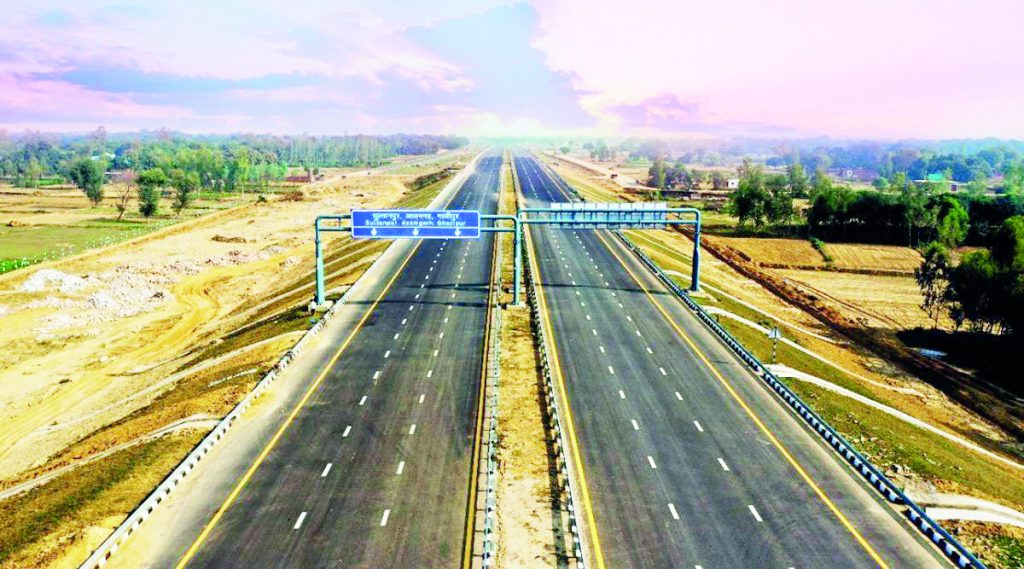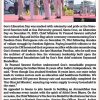Goa is abuzz with excitement as vintage bike and car owners, users, collectors and fans are decking […]

HIGH PROFILE PROJECTS WILL BANKRUPT INDIA! By Vidyadhar Date
May 07 - May 13 2022 May 13, 2022DRAMEBAZI: To project the Yogi Adityanath government the BJP government built the Purvanchal Express Highway on which Prime Minister Narendra Modi dramatically landed in the largest air force transport plane of the country!
Prime Minister Narendra Modi and the BJP government are more interested in building mega projects to acquire the status of a global power. The highways which are broad enough and strong enough to land air-forced transport planes and all the eight lane highways and E-ways are more for dramatizing the prestige of the Modi government. The author points out several times that the Bombay bus transport system, which is among the best in the country, has been sacrificed for a metro system is poorly used by the common public because it is both expensive and public-unfriendly…..
By Vidyadhar Date
THE Modi government’s extravagant projects are being seriously questioned by experts. These include the Metro rail projects and the absurdly expensive proposed high speed railway coming up between Mumbai and Ahmedabad. With the Shiv Sena-led coalition government assuming power in Maharashtra, the high speed project is likely to face strong opposition.
Metro railway alone cannot solve the urban traffic and transport problems. There has to be a substantial increase in the number of buses and facilities for pedestrians. This was the dominant view of experts at the 12th Urban Mobility India Conference held in Lucknow from November 15 to 17 last year and which I attended. The annual conference was organised by the Union Development Ministry.
Experts strongly criticised the dominant official, government policy of giving top importance to Metro while ignoring buses and pedestrians. The government is also inflicting Metro railway on cities which simply do not need them. Besides, they are disrupting heritage cities like Lucknow, Hyderabad and Jaipur.
The most obvious failure is in the host city of Lucknow itself. I experienced it myself. Even during the morning and evening peak hours there were very few people in the train. So the announcement in the train that people should not push one another while getting in or out seemed so laughable. In the morning I saw a man with a bag full of tiffin boxes in the train. At each station he would step out, place a tiffin box on the platform and come back. The security police would pick up the box at each station. It was their breakfast. The man could leisurely place the tiffin dabbas as there was no rush at all. The platforms were all empty.
The Metro is posh and comfortable. But what is the point? Most people cannot afford it. They find it much easier to take a share auto and it is much cheaper too, easily accessible at street level. The Metro fare is clearly high. I paid Rs.40 for a single journey of just four km from Indira Nagar to Badshah Nagar. There are no season tickets. So if a daily traveller spends Rs.80 a day on a return trip it works out to be a hefty amount for one month, far above monthly first class fare in Mumbai suburban railway.
Apart from the high fare, Lucknow and so many other cities simply do not need the Metro. This was emphasised by experts.
Mr Keshav Verma, adviser to the U.P. government and a retired IAS officer who is credited with doing good work in Ahmedabad, said there are few jobs in Lucknow, no big companies or offices. The state government is the biggest employer and the only major one. All its employees travel on their own mostly. They don’t use the Metro. He recalled the work done during his tenure as Ahmedabad municipal commissioner for the Bus Rapid Transport project. A team had been sent to Curitiba in Brazil, a pioneer in BRT.
The extreme hypocrisy and incompetence of the system is so starkly visible in Lucknow. There is a wide road running parallel to the Metro and leading to Faizabad. The entire stretch and most roads totally lack footpaths. There were also many crushed, abandoned old cars lying on roadside and numerous other parked cars blocking traffic.
Mr Keshav Verma said our public works department engineers were simply not exposed to modern ideas. They just widen streets and remove footpaths to serve motorists and in the process make life miserable for the city.
I walked 1.5 km to the conference venue Indira Gandhi Pratishthan in the newly developed, upper class area of Indira Nagar. Particularly noticeable lack of footpath was on a big road named Jananayak Chandrashekhar Marg named after the former prime minister. The high court is adjacent to Pratishthan. There are offices of the Lucknow Development Authority and Lokayuta and Women’s Commission and yet the road is extremely dangerous to cross. There are no traffic lights even at big junctions with heavy traffic. I travel a lot to different cities and never encountered such a dangerous city for pedestrians.
Mr Axel Friedrich, a top expert from the European Union, said in a chat with me before the conference that he walked to the venue from Hilton Hotel which is not far away and it was very difficult in the absence of a footpath. One has to be brave to walk in the city, he said. He also mentioned this before big wigs at the conference during one session.
Yet, Chief Minister Yogi Adityanath and U.P.’s chief secetary Rajendra Kumar Tripathi had the audacity to claim in their speeches at the inaugural session that Lucknow and the state had been made very pedestrian friendly!
My worst experience was while walking to the Residency area where the British lived and this was the site of fighting during the 1857 war of independence or uprising. The footpath to the hot tourist spot was stinking, used as a urinal. The Lucknow Divisional Commissioner Mr Mukesh Meshram, trained as an architect, himself said on his own during the conference that some of the streets smelt of urine.
How the whole establishment is dominated by thinking in favour of motor car oriented development was clear from the venue, the Indira Gandhi Pratishthan. It has facility for parking 1,000 cars. And this in the most prime area. Not surprisingly, Lucknow has very little by way of a city bus service.
Several veterans in the transport industry and bureaucracy were very critical of the priority given to the Metro railway at the cost of other modes of transport. Mr Prasanna Patwardhan, bus fleet operator, said the Metro was like a toy, nice looking but very expensive and useless. A son may demand a Mercedes car and a father may manage to even present him one. But then what remains for education and food and other basic needs?
Experts pointed out that there was a severe shortage of buses. But the authorities were doing little to increase the number of bus services. We need 60 buses per one lakh people but we have only 11 buses. Yet there is no hue and cry over this bitter fact. It is also ironic that there is overproduction of cars and under production of buses. This was an insult to common people.
Mr Shivanand Swamy, executive director of the CEPT Centre for Environment Planning & Technology, a reputed institute in Ahmedabad said the Hubli Dharwad bus rapid transit system was doing very well carrying 95,000 people every day. But no one was talking about such success stories.
He suggested that 10 per cent of funds allotted for Metro railway should be given for bus and pedestrian facilities. Buses in Delhi carry many more passengers than Delhi Metro, he pointed out.
Shreya Gadepalli, south Asia director of the Institute of Transportation & Development, said a survey of government subsidies in Chennai showed a massive subsidy of Rs250 per passenger trip for Metro railway, Rs70 for motorists and Rs2 for buses.
Ravi Gadepalli, IIT-trained researcher working for integrating of bus and other modes of transport, said legal sanction for running buses should be given as in the case of Metro railway. Experts also pointed that Delhi Metro was so expensive some people found it more economical and convenient to drive!
They also pointed out that the Metro would never succeed without proper access for pedestrians and buses. In Lucknow I noticed it was difficult to cross the road and reach metro stations due to dangerous driving and lack of traffic signals. Also buses should not be restricted to feeder routes. In London there are a huge number of buses, some of them operate the whole night. This and restraints on car parking substantially keeps down road congestion. I noticed this during my recent visit.
Geetam Tiwari, a renowned urban transport thinker and IIT Delhi professor, was frustrated that despite years of advocacy of pedestrian rights and facilities of footpaths, there is little headway and the footpath network remains so poor. She also said it was not enough to build footpaths, the streets have to be made lively so pedestrians are encouraged to walk.
She said it was unfortunate that the government has money mainly for the Metro and little for infrastructure for buses and pedestrians. We are so car-obsessed, so the rulers talk of signal-free roads without any regard for pedestrians and foot over bridges are built again with disregard for pedestrians.
The concept of TOD, Transit Oriented Development, was also questionable. Kidwai Nagar was a very people friendly neighbourhood but with TOD it had become a gated community with four cars per flat. This had made the area very unfriendly.
There are a few signs of hope. Ajmal Khan road in congested Karol Bagh in Delhi has been pedestrianised after a lot of interaction with shop-keepers who initially resisted the idea, but now are happy as their business has increased. Varsha Joshi, municipal commissioner for North Delhi, outlined the measures taken.
Unfortunately, higher ups, expert point, are obsessed with the Metro. Mr Durga Shankar Mishra, secretary, Department of Housing & Urban Affairs of the Central government, the big boss of the conference, argued that Metro is not only for transport, it plays a transformational role like an airport raises the status of a city.
The powers be think they can impress foreigners with such symbols of progress. But enlightened experts from the West must be laughing at these ludicrous priorities. Indeed, I saw a veteran from Europe actually laughing at such observations.
Vidyadhar Date is a senior journalist and author of a book making a strong case for public transport and against motor car dominance.
(Courtesy: Counter Currents)















